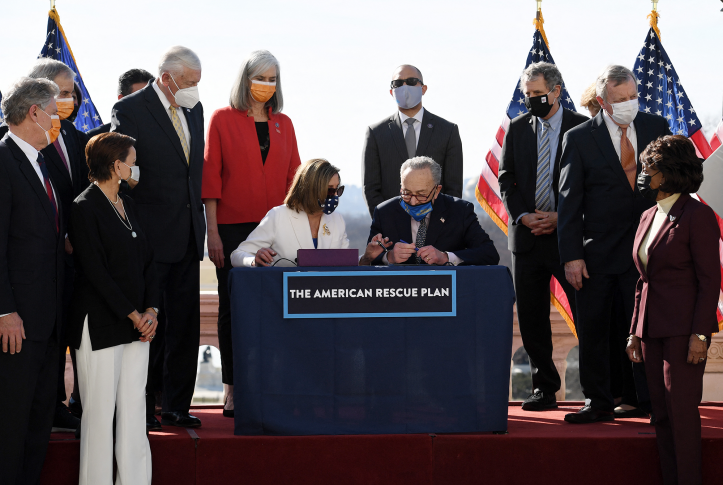The $1.9 trillion American Rescue Plan (ARP) is a comprehensive attempt to address the problems raised by the COVID-19 pandemic and the accompanying economic disruption. One of the most important issues the epidemic has spotlighted is the fact that millions of Americans remain uninsured. The ARP addresses this in three ways: expanded funding for Medicaid and the Children’s Health Insurance Program, COBRA (Consolidated Omnibus Budget Reconciliation Act of 1985) subsidies, and expanded subsidies for marketplace coverage, including for people receiving unemployment insurance. All provisions are temporary but may be made permanent or extended. This post examines the COBRA and marketplace subsidy provisions, which are expected to extend coverage to millions of Americans.
COBRA Coverage Subsidies
COBRA continuation coverage allows people who lose coverage under an employer health plan to purchase it through their employer-sponsored plans (for firms with more than 20 workers). Usually, this lasts up to 18 months. Typically, COBRA coverage is very expensive: the employee must pay a premium of up to 102 percent of its total cost, including the share formerly paid by the employer. But it allows individuals who lose employer coverage to continue to see their doctors and frees them from satisfying a deductible under a new plan.
The ARP, as amended by the Senate, provides a federal subsidy of 100 percent of COBRA premiums for people who lose coverage because they are laid off or their hours have been reduced. The subsidies will be available from April to September 2021 and paid through tax credits to employers with self-insured plans and to insurers for insured plans. Premium subsidies are not considered taxable income to recipients.
Employers and insurers must provide notice of the coverage subsidies to potential beneficiaries when they become eligible as well as when the subsidies end. If people did not enroll in COBRA when they lost their jobs earlier in the pandemic or enrolled but later dropped coverage, they may now enroll in subsidized coverage within 60 days of it becoming available or when they receive the notice from their employer. Under separate guidance from the Department of Labor, people can enroll up to 60 days from the end of the year after their initial eligibility or the end of the current public health emergency, whichever is sooner. This means that individuals who did not enroll in COBRA because of cost late last year or early this year may now enroll in the heavily subsidized COBRA benefits.
The Congressional Budget Office (CBO) estimated that 2.2 million people would enroll in this coverage under the House bill, which only offered 85 percent premium support, but that only 600,000 of them would otherwise have been uninsured. The Senate’s 100 percent subsidy will likely cover more people.
Enhanced Marketplace Subsidies
The ARP also enhances marketplace subsidies. It reduces the percentage of income that individuals must pay for health insurance to become eligible for subsidies, thus increasing both the amount of subsidies and the number of people potentially covered. A calculator for determining the impact of these changes is available here. Enrollees with incomes between 100 percent and 150 percent of the federal poverty level will receive benchmark silver-plan coverage for free. For the first time, subsidies also will be available to people with incomes above 400 percent of the poverty level. Bronze plans will be available for free and gold plans will be quite affordable to enrollees in many states. During the current special-enrollment period, enrollees in states that use HealthCare.gov can change plans. Many people may choose to do so as better coverage becomes more affordable. The legislation will be particularly helpful to older people and those who live in areas with high health insurance premiums, since they are most likely to face unaffordable premiums even if they earn more than 400 percent of the poverty level. Unfortunately, the enhanced premium support will only last for two years, although it is retroactive to the beginning of 2021.
The ARP does nothing to decrease cost-sharing. The high cost-sharing imposed by marketplace silver plans will leave health care services financially burdensome for all but the lowest-income enrollees. The CBO estimates that the premium reductions will increase marketplace coverage by 1.7 million people, 1.3 million of whom would otherwise be uninsured.
Further Premium Tax Credit Provisions
Two other ARP provisions deal with premium tax credits. Americans who experienced income loss and fluctuations in 2020 or who received unemployment compensation they did not understand would be taxable may have tax credit overpayments. The rescue plan frees them from the obligation to pay these back. Many will have already paid their taxes; the IRS will have to determine how to return their money.
The ARP provides that anyone who received unemployment compensation at any point during 2021 and is not otherwise eligible for health coverage can receive the maximum subsidies for marketplace coverage and cost-sharing reductions. The provision is not limited to people who earned more than 100 percent of the poverty level, unlike the ACA’s general premium tax credits, and so could help people in states that have not expanded Medicaid.
Unfortunately, this provision does not eliminate the ACA’s family glitch. If a family includes an unemployed individual and an individual who is receiving individual employment coverage that is affordable and is also eligible for family coverage that is not affordable, the entire family will not be eligible for premium tax credits.
The CBO estimates that this provision will help 1.4 million people; 900,000 of these would otherwise be entitled to marketplace coverage with higher premiums.
It will take work and time to implement these provisions, but ultimately they will significantly expand access to health care for many Americans.




